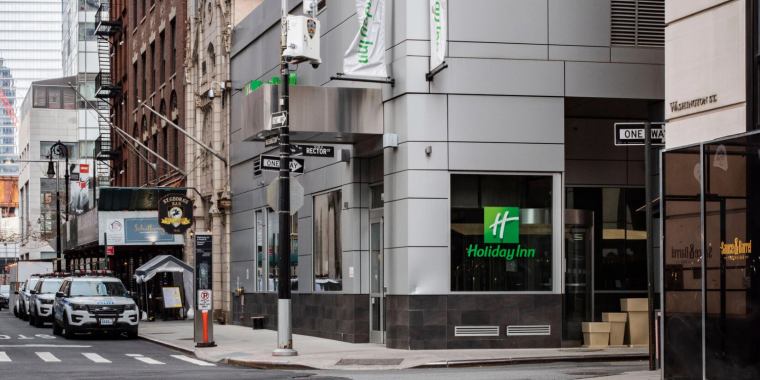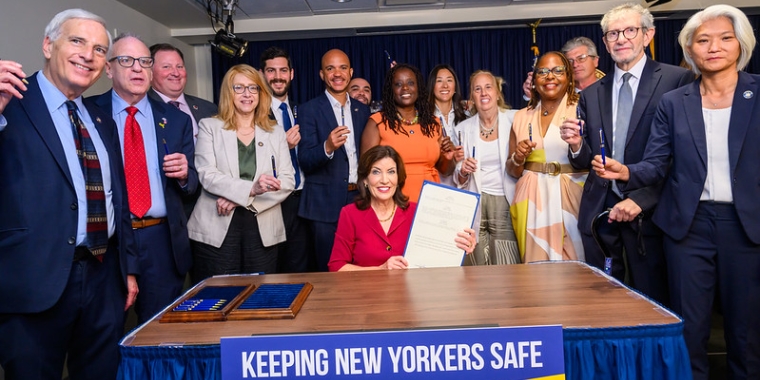New York Times: What Will Happen to All the Empty Office Buildings and Hotels?

The Holiday Inn FiDi, a large hotel in Lower Manhattan, is now in foreclosure after defaulting on its loans. Some developers are pushing to convert struggling hotels like this one to affordable housing, Katherine Marks for The New York Times
On Friday, April 16, 2021, C.J. Hughes covered the possibilities and plans of using buildings that have become vacant, due to the pandemic, for alternative purposes, including housing. The full text of the story is below; the original is available via the link above.
_______________
What Will Happen to All the Empty Office Buildings and Hotels?
Commercial real estate has been hit hard by the pandemic, but there are plans to convert some of the now-empty spaces into apartment buildings.
By C.J. Hughes
April 16, 2021
Dark windows. Quiet lobbies. Hushed halls.
Many of New York’s hotels and office buildings have been empty for more than a year now as the pandemic continues to keep tourists and workers out of the city.
And some of those properties may never recover. An effort is afoot to take these eerily empty commercial structures and convert them to housing of some kind and perhaps other uses as well, potentially spurring a number of building conversions not seen since the crash of the late 1980s.
But in the development world, top-to-bottom makeovers can take years, and a robust recovery could make landlords think twice about reinventions. Space and safety requirements could also complicate some conversions, real estate executives say.
Still, with some companies allowing employees to permanently work from home, and officials bracing for tourism to not fully recover for years, there is support across the city for breathing new life into struggling buildings.
“Covid has expedited the ultimate repurposings,” said Nathan Berman, the managing principal of Metroloft Management, a developer in the process of buying two large office buildings in Lower Manhattan that have been hammered by the pandemic.
These shell-of-their-former-selves buildings, which Mr. Berman declined to name while negotiations continue, would become market-rate rentals. “They are perfect targets,” he said.
From corporate high-rises in the financial district to boutique lodgings near Central Park to mid-market accommodations in Midtown, real estate players are redeveloping or canvassing dozens of sites, according to those involved.
So far, most of the attention has been trained on Manhattan, home to the city’s largest business and tourism districts, and where the pandemic has dealt the harshest blows. But hotels in Brooklyn, where prices for buildings are generally lower, are also getting a look.
The conversions seem to fall into three categories: offices to housing, hotels to housing, and hotels turning into offices, though not for long stays but short-term sessions.
“It’s definitely all happening, for sure,” said Eric Anton, an agent with the firm Marcus and Millichap who specializes in selling buildings. Of the seven hotels in New York he currently represents, three will likely become senior housing, one will become market-rate apartments, and the balance will stay hotels.
“But a lot of the conversations revolve around whether the conversions can happen efficiently,” Mr. Anton said.
Boardrooms to Bedrooms
Some buildings, of course, can be converted more easily than others.
Decades ago, prewar office buildings were all the rage for reinvention. In the financial district, which became hollowed out after insurance companies and investment banks moved uptown, developers grabbed up limestone and granite former headquarters and sliced them up into apartments.
But there aren’t many of those grand old buildings left, at least downtown, forcing developers to consider newer structures, like glassy mid-20th-century office towers, which in some cases have become obsolete as fancier offerings have risen around them.
In March, more than 17 percent of Manhattan’s office space was vacant or soon to be, with a slightly higher rate downtown, according to CBRE, the real estate firm. Few of those spaces have been so empty since the early 1990s.
Though many landlords are long-term investors who don’t panic in tumultuous times, the ghost-town vibe may be at least causing jitters. Since the pandemic began a year ago, city projections suggest that Manhattan office towers are worth 25 percent less.
Mr. Berman, who for years converted mostly prewar properties, like 67 Wall Street, 84 William Street and 20 Exchange Place, has lately gone Modernist himself. The two office buildings he is now in talks to buy went up in the postwar period, he said, adding that they are also of the “Class B” variety, industry-speak for “a bit drab.”
“It’s too expensive to upgrade those kinds of buildings, so a change of use is really the optimum path,” said Mr. Berman, adding that they also aren’t usually landmarks, which reduces the number of necessary permits.
But how easily can structures where people once pecked at computers and huddled in conference rooms become places to live?
It really depends, said the architect John Cetra, a co-founder of the firm CetraRuddy, which has made bedrooms out of boardrooms at several Manhattan addresses.
One major factor is the distance between the facade and the elevators, otherwise known as a “lease span.” When it comes to creating housing, the smaller the lease span, the better, according to Mr. Cetra.
A span of 30 feet is ideal, said Mr. Cetra, as he recently led a tour of 20 Broad Street, a 1957 former office building next to the New York Stock Exchange that in 2018 swapped its stockbrokers for residents. (Its thick-doored bank vault remains in the basement though, and now serves as a lounge.)
At 20 Broad, a CetraRuddy project, the lease span measures 45 feet, which is close to the outer limit of what can work, he explained, adding that anything greater “just becomes too awkward,” because apartments would likely have to have large windowless spaces and other hard-to-adapt spaces.
But recently constructed office buildings often have lease spans of 50 feet or more, Mr. Cetra said, suggesting that laying out conventional apartments in them could be difficult.
Focusing on the floor plans at 20 Broad, which has 533 rental units across 30 stories, then, can be instructive. Reaching the living room in No. 721, an alcove studio on the seventh floor, for instance, requires navigating a long gangplank-like hall. But what could have been a void between the front door and a couch has been filled creatively — with a closet, a washer and dryer and the alcove, which can fit a bed but has no windows. Also squeezed in, along one wall, in what might be called a half-galley-style, is a kitchen.
Mr. Cetra is the first to admit that the quirks, which in No. 721 includes an off-center window, are unavoidable when tackling a commercial conversion. But on the plus side, no two units seem the same. “You’re not doing cookie-cutter apartments,” he said. “You get so much more variety.”
The studio, with about 500 square feet, is listed at $3,760 per month. But to help fill the building, which is grappling with a 40 percent Covid-related vacancy rate, its landlord, Metroloft, is dangling four months of free rent, so renters would essentially pay $2,600 a month.
No More Room Service
It’s a hard time to be a hotelier. Facing a drought of tourists and business travelers, about 200 of the city’s 700 hotels have closed since Covid hit, and many of those closures are expected to be permanent, especially as debts mount.
There are also many soured loans. Since fall, hotels in the New York City area have led the country in terms of delinquencies, according to the analytics firm Trepp, which tracks securitized mortgages. In April, New York hotels accounted for $1.8 billion in unpaid balances, far outpacing second-place Chicago with about $1 billion past due.
Even though the construction of new hotel rooms does continue in the city, there have been casualties, both big and small. Hilton Times Square, a 476-room hotel, shuttered last fall, and after months when the owner, Sunstone Hotel Investors, failed to make loan payments, wound up this winter in the hands of a lender with an uncertain fate.
Similarly, the Holiday Inn FiDi, a soaring 50-story, 492-room high-rise near the National Sept. 11 Memorial and Museum, is now in foreclosure because of its three troubled loans, according to Trepp. But relatively small properties are in tight spots as well, like the 72-room Hotel Giraffe on Park Avenue South, which has fallen more than three months behind with its mortgage checks.
What’s still up and running is often not being run as a typical hotel. Starting a year ago, in an effort to stop the spread of Covid in often cramped shelters, more than 60 city hotels became shelters for 9,500 homeless people, an arrangement that continues at many addresses.
But developers are starting to consider struggling hotels as potential investments. This month, Yellowstone Real Estate Investments plunked down $175 million for the 600-room Watson Hotel in Midtown that in many ways is an emblem of the embattled hospitality sector.
Long a Holiday Inn, the West 57th Street property was reinvented as a boutique getaway in 2017 by a new owner, BD Hotels, whose portfolio includes downtown hot spots like the Mercer, the Bowery and the Jane. But then Covid hit, and BD defaulted, despite turning much of the Watson Hotel into a homeless shelter, for which the city reimbursed it.
For the 1964 building’s newest chapter, Yellowstone will turn one of the hotel’s two towers into market-rate apartments, according to sources familiar with the deal, while leaving the other tower as a hotel. Isaac Hera, the firm’s chief executive, said in an email that plans were not set yet, but added that “having the flexibility of implementing different uses and different business plans is a very attractive proposition.”
City and state officials have pushed for the conversion of hotels into affordable housing, but developers note that building codes could make that difficult.
For starters, apartments must be at least 150 square feet, while hotel rooms are allowed to be smaller. And apartments require kitchens, though in some affordable-housing complexes, tenants can share kitchen facilities, said Mark Ginsberg, a principal at Curtis + Ginsberg Architects, which has designed affordable projects.
Adding kitchens and enlarging rooms to meet codes could also ultimately reduce the number of beds, a counterproductive move, Mr. Ginsberg said. It could also balloon costs, turning a standard hotel makeover with $3 million in cosmetic changes into a $30 million overhaul.
The process seems so daunting that an investor interested in converting a struggling 60-room hotel on the Lower East Side is getting cold feet, said Mr. Ginsberg, who is assessing the site for the investor.
Since last spring, Mr. Ginsberg has looked at about a half dozen other hotel sites for similar clients. “With the destruction of the tourism industry, this is the time to act,” he said.
It can also be tricky to identify ideal sites, said Ted Houghton, the head of Gateway Housing, an affordable-housing developer that creates what is known as supportive housing, which provides some social services on-site.
Hotels in industrial areas seem to be low-hanging fruit, said Mr. Houghton, who began his career in the late 1980s, during another housing crash, by helping create supportive housing in the crumbling Times Square Hotel on West 43rd Street.
Many neighbors don’t approve of hotels in industrial zones because they take land away from true manufacturers, he said. About 250 of New York’s 700 hotels are in such zones, though you wouldn’t always know an industrial zone when you see one. The Mercer, in ritzy SoHo, for example, is in one, as is the line of hotels along Wythe Avenue in Williamsburg, Brooklyn — though converting those locations to affordable housing could also stir controversy.
“No hotel has a for-sale sign on it, but every hotel could be for sale,” Mr. Houghton said.
Streamlining the redesign process so that old hotels can become affordable housing is a priority of State Senator Brian Kavanagh, a Democrat who represents parts of Brooklyn and the Lower East Side. He is sponsoring a bill that would allow developers to convert hotels into affordable housing without having to get the kinds of building permits required for new residential properties. Also, the law would apply only to hotels in industrial zones within about a block of residential neighborhoods.
“You don’t want to be dropping affordable housing into the middle of a desert,” said Mr. Kavanagh, who added that offices would be much harder to convert. “It would be too expensive, even with subsidies. That would probably happen only with market-rate apartments.”
Similarly, a bill from Michael Gianaris, a State Senator from Queens, would give the state power to buy distressed hotels and office buildings, and redevelop them into housing for low-income and homeless tenants, though most Manhattan addresses would be excluded. Gov. Andrew M. Cuomo has also discussed similar goals.
The state budget passed this month allocates $100 million to reinvent hotels as affordable housing. Plus, $270 million in the federal American Rescue Plan is designated for the homeless in New York, and those funds could potentially help finance conversions as well. “There is a sense of a real opportunity here,” Mr. Kavanagh said.
Coming Full Circle
In a city where renewal takes odd turns — churches have morphed into nightclubs, factories into fashion shops, and post offices into train stations — it should come as no surprise that some buildings can revert to their original purpose years later.
That’s what’s happening at 960 Sixth Avenue, a 16-story limestone edifice at West 35th Street that began life as an office building, had a brief turn as a hotel, and is now set to welcome workers again in May.
Opening in 1930, the building housed fabric textile showrooms and yarn firms for much of the 20th century, before Atlantic Bank of New York took it over for its headquarters. In the late 2000s, an attempt by the Statuto Group, an Italian firm, to recast the building with a mix of creative tenants fell flat because of the Great Recession, and a foreclosure followed. The next owner, the developer Hidrock Properties, then created a 167-key outpost of Courtyard by Marriott. But after eight years in operation, the coronavirus put the hotel out of business last year.
Now, the building, which also goes by 8 Herald Square, is transforming itself into a co-working hub from the Yard, a Brooklyn-based company. In a third-floor area that used to welcome tourists, the Yard has removed the reception desk and couches, and replaced them with conference rooms, phone booths and a kitchen. And in hotel rooms above, the Yard has replaced beds with desks — sometimes four to a room — while installing fake plants in shower stalls to make them less hotel-like.
Desks rent for about $500 a month, in leases as short as 30 days, said Richard Beyda, a Yard co-founder, who looked at several other shuttered lodgings before landing there.
“It felt like a hotel until we did our usual aesthetics,” said Mr. Beyda of his first hotel-to-office job. And while some may look around at all the empty office buildings and grimace, Mr. Beyda sees an ecosystem that’s adapting.
Workers who no longer want to punch in for a nine-to-five experience might come around eventually, warming to his firm’s more flexible workplace strategy. “It might be the only silver lining of the pandemic,” he said.
And at least one landlord is considering the ultimate repurposing: demolition.
Vornado Realty Trust announced plans this month to raze the Hotel Pennsylvania, a 1,700-room building across from Madison Square Garden that opened in 1919, but has been shuttered for more than a year, and replace it with an office tower layered with outdoor gardens.
The Hotel Pennsylvania “is decades past its glory and sell-by date,” said Steven Roth, Vornado’s chairman, in a letter to shareholders. But he also suggested that there were fundamental problems with the city’s hospitality industry that predate the pandemic.
“The hotel math has deteriorated significantly over the last five years,” Mr. Roth wrote, “a victim of oversupply, relentlessly rising costs and taxes, and an aging physical plant.”


